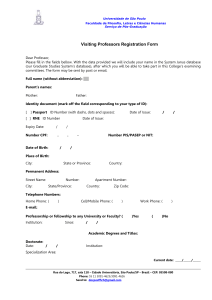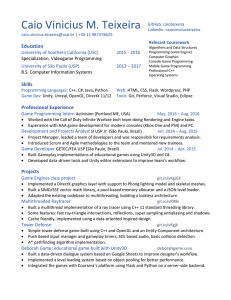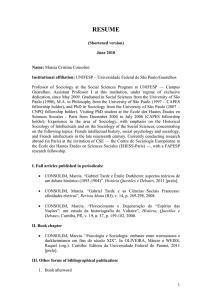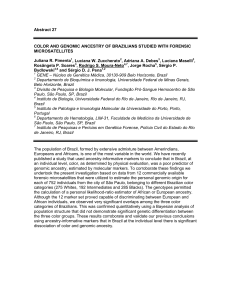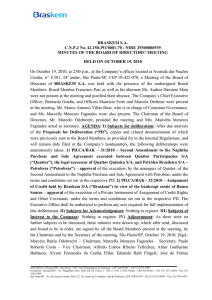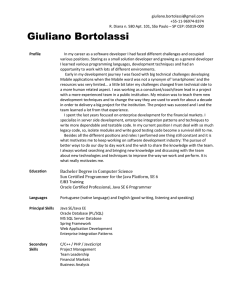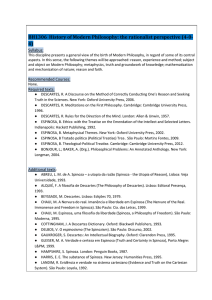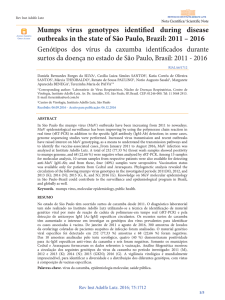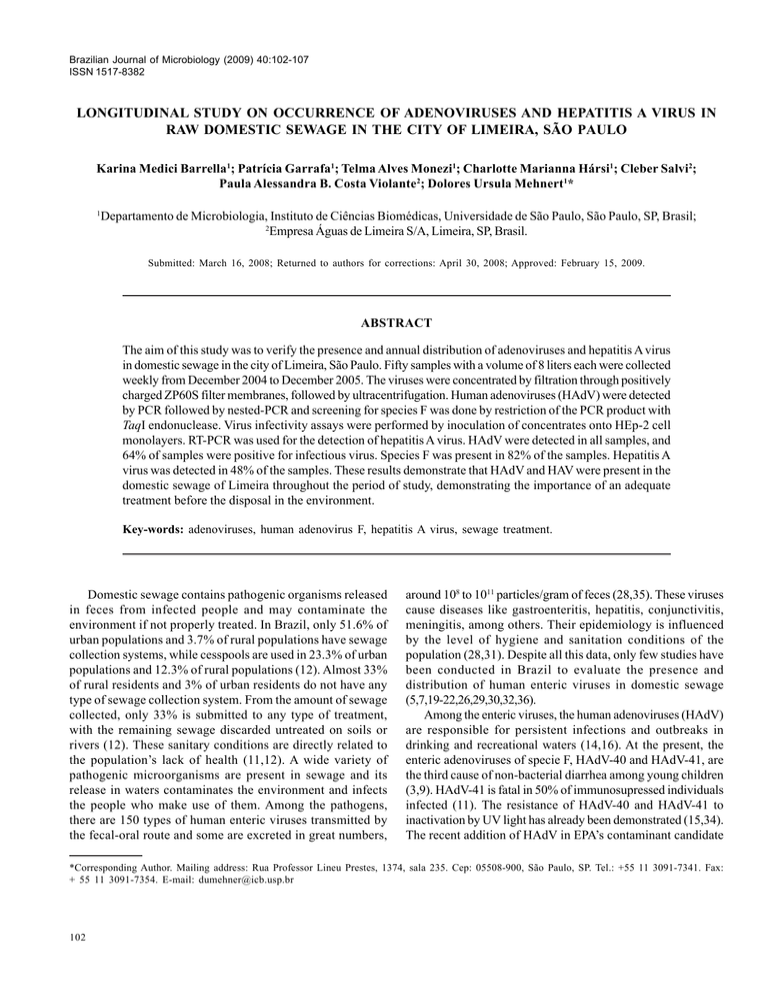
Brazilian Journal of Microbiology (2009) 40:102-107
ISSN 1517-8382
LONGITUDINAL STUDY ON OCCURRENCE OF ADENOVIRUSES AND HEPATITIS A VIRUS IN
RAW DOMESTIC SEWAGE IN THE CITY OF LIMEIRA, SÃO PAULO
Karina Medici Barrella1; Patrícia Garrafa1; Telma Alves Monezi1; Charlotte Marianna Hársi1; Cleber Salvi2;
Paula Alessandra B. Costa Violante2; Dolores Ursula Mehnert1*
1
Departamento de Microbiologia, Instituto de Ciências Biomédicas, Universidade de São Paulo, São Paulo, SP, Brasil;
2
Empresa Águas de Limeira S/A, Limeira, SP, Brasil.
Submitted: March 16, 2008; Returned to authors for corrections: April 30, 2008; Approved: February 15, 2009.
ABSTRACT
The aim of this study was to verify the presence and annual distribution of adenoviruses and hepatitis A virus
in domestic sewage in the city of Limeira, São Paulo. Fifty samples with a volume of 8 liters each were collected
weekly from December 2004 to December 2005. The viruses were concentrated by filtration through positively
charged ZP60S filter membranes, followed by ultracentrifugation. Human adenoviruses (HAdV) were detected
by PCR followed by nested-PCR and screening for species F was done by restriction of the PCR product with
TaqI endonuclease. Virus infectivity assays were performed by inoculation of concentrates onto HEp-2 cell
monolayers. RT-PCR was used for the detection of hepatitis A virus. HAdV were detected in all samples, and
64% of samples were positive for infectious virus. Species F was present in 82% of the samples. Hepatitis A
virus was detected in 48% of the samples. These results demonstrate that HAdV and HAV were present in the
domestic sewage of Limeira throughout the period of study, demonstrating the importance of an adequate
treatment before the disposal in the environment.
Key-words: adenoviruses, human adenovirus F, hepatitis A virus, sewage treatment.
Domestic sewage contains pathogenic organisms released
in feces from infected people and may contaminate the
environment if not properly treated. In Brazil, only 51.6% of
urban populations and 3.7% of rural populations have sewage
collection systems, while cesspools are used in 23.3% of urban
populations and 12.3% of rural populations (12). Almost 33%
of rural residents and 3% of urban residents do not have any
type of sewage collection system. From the amount of sewage
collected, only 33% is submitted to any type of treatment,
with the remaining sewage discarded untreated on soils or
rivers (12). These sanitary conditions are directly related to
the population’s lack of health (11,12). A wide variety of
pathogenic microorganisms are present in sewage and its
release in waters contaminates the environment and infects
the people who make use of them. Among the pathogens,
there are 150 types of human enteric viruses transmitted by
the fecal-oral route and some are excreted in great numbers,
around 108 to 1011 particles/gram of feces (28,35). These viruses
cause diseases like gastroenteritis, hepatitis, conjunctivitis,
meningitis, among others. Their epidemiology is influenced
by the level of hygiene and sanitation conditions of the
population (28,31). Despite all this data, only few studies have
been conducted in Brazil to evaluate the presence and
distribution of human enteric viruses in domestic sewage
(5,7,19-22,26,29,30,32,36).
Among the enteric viruses, the human adenoviruses (HAdV)
are responsible for persistent infections and outbreaks in
drinking and recreational waters (14,16). At the present, the
enteric adenoviruses of specie F, HAdV-40 and HAdV-41, are
the third cause of non-bacterial diarrhea among young children
(3,9). HAdV-41 is fatal in 50% of immunosupressed individuals
infected (11). The resistance of HAdV-40 and HAdV-41 to
inactivation by UV light has already been demonstrated (15,34).
The recent addition of HAdV in EPA’s contaminant candidate
*Corresponding Author. Mailing address: Rua Professor Lineu Prestes, 1374, sala 235. Cep: 05508-900, São Paulo, SP. Tel.: +55 11 3091-7341. Fax:
+ 55 11 3091-7354. E-mail: [email protected]
102
Adenovirus and Hep A virus in sewage
list indicates a high priority for a possible recommendation of
their use as an indicator of water quality (18).
Hepatitis A viruses (HAV) are responsible for outbreaks
worldwide, with 1.4 million cases per year, affecting mainly children
and adults older than 50 years (38). The release of viruses in
feces occurs from 3 to 10 days before the establishment of clinical
symptoms and up to 8 days after the manifestation of jaundice
(10). HAV epidemiology is greatly influenced by the level of
sanitation and hygiene. Infections occur during childhood and
almost 100% of children acquire immunity until the age of ten
(10,38). The improvement of sanitation and hygiene in some
countries has changed this incidence, showing now a greater
susceptibility of young adults (33). Like HAdV, studies have also
demonstrated the occurrence of HAV in domestic sewage (24,30).
Although the HAV is a simple positive strand RNA virus, it is
highly resistant to thermic denaturation, treatment with acids,
chloroform, perchloroacetic acid and detergents (10,38).
Considering the possibility of HAdV and HAV being
included in international and Brazilian regulations as better
parameters than bacteria to evaluate the efficiency of sewage
treatment due to their greater resistance, the aim of the present
study was to evaluate the occurrence and distribution of HAdV,
including the species F, and HAV in the domestic sewage of the
city of Limeira, SP, throughout a year.
MATERIAL AND METHODS
Samples collection
A total of fifty samples of raw domestic sewage were collected
weekly at the sewage treatment plant in the city of Limeira, São
Paulo, from December 2004 to December 2005. Eight-liter samples
were collected and immediately processed.
Sample processing
Viruses were concentrated by filtration through positively
charged ZP60S (AMF, Cuno Div., Meridenn, Conn.) filter
membranes and subsequent ultracentrifugation as described
by Mehnert et al. (21) Detoxification of concentrates was done
by organic extraction using Vertrel-XF (1, 1, 1, 2, 3, 4, 4, 5, 5, 5, 5,
5 - decafluoropentane, Clarus®, Hortolândia, SP) as previously
described (27).
For the molecular assays, the viral nucleic acid (DNA for
HAdV and RNA for HAV) extraction was performed using
Trizol™ (Invitrogen, Carlsbad, California), as recommended by
the manufacturer. For viral infectivity assays, 500 μL aliquots of
samples were treated with antibiotics (1000 IU of penicillin G/
mL and 1,000 μg/mL of streptomycin) (19). All samples were
stored in -20ºC or -70ºC (RNA) until their use.
Cell cultures and viruses
The viruses were cultivated in specific cell culture lines:
HEp-2 (human epidermoid carcinoma of larynx) for HAdV-5;
HEK-293 (human kidney embryonic cell line, transformed with
HAdV-5) for adenovirus F and FRhK-4 (fetal rhesus kidney
cell) for HAV (HM-175 strain). All cell lines were grown in Eagle´s
minimum essential medium supplemented with 10% fetal bovine
serum (Emcare, Campinas, Brazil) and antibiotics (100U of
penicillin G/mL and 100 μg/mL of streptomycin).
Control strains of human adenoviruses C (HAdV-5) and F
were kindly provided by Prof. Charlotte M. Hársi. For the
detection of HAV, the control strain HM-175, was kindly
provided by Prof. Ana Maria Gaspar, Department of Virology,
FIOCRUZ. Control strains were inoculated onto 75% confluent
monolayers of either cell line and incubated for 48 to 72 hours at
37ºC in a 5% CO2 atmosphere.
PCR and RT-PCR. For the detection of HAdV by PCR the
primers hexAA1885 and hexAA1913, for the amplification of a
301 bp fragment of the hexon protein gene were used (2). The
HAdV PCR was performed as described by Allard et al (2), with
modifications by Santos et al (29).
The samples that were negative at the first amplification had
their product subjected to a second round of amplification
(nested-PCR) using primers nehexAA1893 and nehexAA1905
which amplify a 143 bp fragment (3).
The detection of HAV was performed using the primers
HAV-CL and HAV-CR of De Leon et al. (6), which correspond
to the region between the coat protein VP1 and VP3 genes and
amplify a 207 bp fragment. The RNA genome of the viruses
was reverse transcribed into cDNA using the Moloney murine
leukemia virus reverse transcriptase (M.M.L.V.; Invitrogen) and
the respective pair of primers (6). The RT-PCR was done
following the procedure described by De Leon et al. (6) and
modified by Sassaroli (30).
All the PCR runs included ultrapure water (Milli-Q®) treated
with 0.01% diethilpyrocarbonate (DEPC) as negative controls.
Samples that did not show amplification of naturally occurring
adenoviruses were seeded with 5 μL of viral DNA and reamplified
by PCR to evaluate the interference by inhibitors.
Amplification products were analyzed by 1.5% agarose gel
electrophoresis in TAE buffer and ethidium bromide (0.5 μg/
mL) staining.
HAdV species F characterization. The distinction of enteric
adenoviruses (species F) from the other species was performed
by restriction fragment lenght polymorfism (PCR-RFLP). The
digestion of the 301 bp amplicons was performed by using
restriction endonuclease TaqI (Fermentas ®), following
procedures described by Santos et al. (29). Restriction profiles
were analyzed by 1.5% agarose gel electrophoresis in TAE
buffer and ethidium bromide (0.5 μg/mL) staining.
Infectivity assays. Samples were subcultured three times in
HEp-2 cells for virus isolation. Duplicate cell monolayers were
inoculated with 100 μL of each sample. Cultures were incubated
at 37ºC in 5% CO2 for 10 days and observed daily for cythopatic
effect (CPE).
103
Barrella, K.M. et al.
RESULTS AND DISCUSSION
Among the enteric viruses, adenoviruses and hepatitis A
viruses have their importance for Public Health due their
resistance and high rate of outbreaks worldwide (8,10,15,18,
25,34). In Brazil there is a lack of information on the occurrence
of human enteric viruses in domestic sewage and its
correlation with possible outbreaks. Most of data were
obtained from large cities like São Paulo (5,7,19-22,26,29,
30,32,36) and there is no data available from rural areas of São
Paulo state.
The city of Limeira was chosen for this study due to its
geographical and demographical aspects. Located in the
countryside of São Paulo state, it has 272.734 inhabitants (13)
and the collection and treatment of both water and sewage are
done by a private company, Águas de Limeira S/A. At present,
the company collects 100% of domestic sewage and treats 77%
of it (4). This is a high percentage when compared to the
country’s average, where 53% of sewage is collected and 34%
treated (12). It is not uncommon to find illegal discharges of
industrial effluents that may adversely affect the treatment. There
are three sewage treatment plants and Tatu is the largest one,
with a primary treatment that reduces 40% of biological oxygen
demand before discharging in the Tatu river (1).
Adenoviruses. Of the 50 samples of domestic sewage, 42
(84%) samples were positive after the first round of PCR. Eight
(16%) additional samples were positive for adenoviruses after
nested-PCR, showing that the viruses were present in low
concentrations in these samples.
The characterization of species F by RFLP was based on the
presence of a restriction site for the endonuclease TaqI located
in the hexon gene sequence. The amplicons from HAdV-40 and
HAdV-41 present two restriction fragments of 191bp and 110bp
after the digestion, while the adenoviruses from other species
(HAdV-A to E) do not (3,29). Based on this assay, the presence
of human adenovirus from species F was detected in 41 (82%)
samples and only 1 (2%) sample did not show human
adenovirus F. Eight (16%) samples were not characterized due
to low DNA concentration for the restriction assay. Of the 42
samples submitted to characterization, 40 (92,9%) samples
presented non-restricted fragments of 301 bp, revealing the
presence of the other serotypes of adenoviruses. This result is
not a surprise, because all the other serotypes are also excreted
in feces.
Viral infectivity assays revealed that 32 (64%) of the samples
contained infectious adenoviruses. These results may be
underestimated due to the great diversity of other enteric viruses
in those samples, like enterovirus, which have a faster replicative
cycle than adenoviruses, damaging the cells just a few hours
after infection (data not shown).
The high occurrence of adenoviruses and the diversity of
species in raw domestic sewage agree with the results from
104
previous studies in the cities of Barcelona (23) and São Paulo
(29). Although the molecular techniques can not distinguish
infectious from non infectious viruses, the infectivity assays
showed that most of the samples contained infectious
adenoviruses. As most samples had adenoviruses detected at
the first PCR, which detection limit is 10-4 DICT50 as previously
established by Santos et al. (29), the results suggest a high
concentration of adenoviruses in sewage.
Hepatitis A. Of the 50 samples subjected to the RT-PCR
reaction for HAV detection, 24 (48%) samples were positive.
These results are similar to those previously observed for raw
domestic sewage of the city of São Paulo (30). Although the RTPCR can not distinguish between infectious and non-infectious
particles, in the case of single strand RNA viruses like HAV, a
positive result in RT-PCR suggests the recent presence of
potentially infectious viruses in the sewage. The viruses
detected by RT-PCR were considered infectious, because the
viral genome is infectious per se, and rapidly degraded after the
release of the capsid (17). The detection of HAV in 48% of
samples also demonstrates the stability of the virus in the
environment.
The occurrence of both types of enteric viruses in the
domestic sewage of Limeira throughout this study is shown in
Table 1 and their annual distribution in Fig. 1.
Both viruses did not show a seasonal distribution in the
domestic sewage of Limeira during the period of study and all
samples showed at least one type of virus. The absence of HAV
in October and a low positivity in August, November and
December may be due to the destruction of the viral particles
due to illegal discharge of industrial effluent in the domestic
sewage (Águas de Limeira, data not shown).
The data demonstrate a continuous release of HAdV and
HAV by the population of Limeira and are similar to other studies
on detection of enteric viruses in sewage, not only in Brazil, but
also in Spain (7,17,19,20,22-26,29,30,32,36). The persistence of
infectious viruses and the absence of seasonality emphasize
Figure 1. of HAdV and HAV positive domestic sewage samples
from December 2004 to December 2005.
Adenovirus and Hep A virus in sewage
Table 1. Detection of HAdV and HAV in the domestic sewage of Limeira from December 2004 to December 2005 using molecular
and cell culture methods.
Detection methods
Month
No. of samples
examined
Adenoviruses
RFLP
HAV
PCR
Nested-PCR
CC
F+
others
Only
Species F
Only other
species
RT-PCR
Dec./04
Jan./05
Feb./05
Mar./05
Apr./05
May./05
Jun./05
Jul./05
Aug./05
Sep./05
Oct./05
Nov./05
Dec./05
4
4
3
4
4
4
3
4
5
3
4
4
4
2
4
3
4
2
1
3
3
5
3
4
4
4
2
NT
NT
NT
2
3
NT
1
NT
NT
NT
NT
NT
1
2
2
3
4
3
3
2
2
2
3
2
3
1
4
3
4
2
1
3
3
5
3
3
3
4
ND
ND
ND
ND
ND
ND
ND
ND
ND
ND
1
1
ND
1
ND
ND
ND
ND
ND
ND
ND
ND
ND
ND
ND
ND
3
3
2
2
1
3
2
2
1
2
ND
2
1
Total
%
50
42
84%
8
16%
32
64%
39
78%
2
4%
1
2%
24
48%
CC = cell culture; NT = Not tested due to detection on first PCR; ND = not detected.
their importance to public health. Considering the low infective
dose of these viruses that may range from 10 to 100 particles
(37), the release of domestic sewage in rivers without adequate
treatment is not recommended, as it may be a source of
dissemination of hepatitis A, diarrhea, gastroenteritis, respiratory
infectious diseases, among others (11,16).
The viral infections may harm not only the health of people
who live in places where there is a lack or absence of sanitation,
but it also harms the local economy, when employees are ill and
unable to work (38). An increase in the number of sewage
treatment plants during the last few years (4) and the possibility
to use sewage by-products (biosolids) in agriculture reinforces
the importance of systematic studies of the viruses circulating
in sewage in different regions of the country (28,31).
The results of the study may be used as a source of
information to justify the importance of implementing effective
sewage treatment plants to inactivate viral particles before final
disposal in the environment.
ACKNOWLEDGMENTS
This work was supported by Fundação de Amparo à
Pesquisa do Estado de São Paulo, Fapesp. Grant nº 04/15120-2
and fellowship nº 05/11282-8.
We thank Empresa Águas de Limeira S/A and collaborators
for the access to the sewage treatment plant and for providing
facilities for sample processing.
We also thank Dr. George D. Di Giovanni for manuscript
review.
RESUMO
Estudo longitudinal da ocorrência de adenovírus e
vírus da hepatite A em esgoto doméstico na cidade de
Limeira, SP
O objetivo do estudo foi verificar a ocorrência e a distribuição
anual de adenovírus humanos e vírus da Hepatite A (VHA) no
efluente doméstico da cidade de Limeira, São Paulo, ao longo do
período de Dezembro de 2004 e Dezembro de 2005, com vistas à
futura implementação de sistemas de tratmento de água de
esgoto. Cinquenta amostras de efluente bruto com volume de
8L cada foram colhidas semanalmente e os vírus concentrados
por filtração em membrana eletropositiva ZP60S, seguida de
ultracentrifugação. Adenovírus foram detectados por PCR e
nested-PCR. Adenovírus da espécie F foram distinguidos das
demais por restrição do produto da PCR com endonuclease TaqI.
Ensaios de infectividade viral foram realizados em culturas de
105
Barrella, K.M. et al.
células HEp-2. A presença do vírus da hepatite A também foi
pesquisada nas mesmas amostras, fazendo-se uso de método
de RT-PCR. Adenovírus foram detectados em todas as amostras,
sendo a espécie F identificada em 82% destas. Sessenta e quatro
por cento dos adenovírus detectados ainda estavam infecciosos.
O vírus da Hepatite A foi detectado em 48% das amostras
examinadas. Estes resultados evidenciam a presença e a
circulação de Adenovírus humano e VHA nas águas de esgoto
doméstico de Limeira ao longo do período de estudo,
demonstrando a importância de um tratamento adequado desse
material antes da disposição no meio ambiente.
Palavras-chave: adenovírus, adenovírus espécie F, vírus da
hepatite A, efluente doméstico.
REFERENCES
1.
2.
3.
4.
5.
6.
7.
8.
9.
10.
11.
12.
13.
106
Águas de Limeira. Information on sewage treatment plants from the
company. http://www.aguasdelimeira.com.br. Acessed 12 November
2007.
Allard, A.; Girones, R.; Juto, P.; Wadell, G. (1990). Polymerase chain
reaction for detection of adenoviruses in stool samples. J. Clin.
Microbiol. 28, 2659-2667.
Allard, A.; Albinsson, B.; Wadell, G. (1992). Detection of adenovirus
in stools from healthy persons and patients with diarrhea by twostep polymerase chain reaction. J. Med Virol. 37: 149-157.
Brasil. Ministério das Cidades. (2006). Sistema nacional de
informações sobre saneamento: diagnóstico dos serviços de água e
esgoto – 2005. Brasília: Mcidades.SMSA. 222p. Available at http://
www.cidades.pmss.gov.br. Accessed August 2007.
Christovão, D.A.; Candeias, J.A.N.; Iaria, S.T. (1967). Condições
sanitárias das águas de irrigação de hortas do município de S. Paulo.
II. Isolamento de vírus entéricos. Rev. Saude Publica. 1: 12-17.
De Leon, R.; Shieh, C.; Baric, R.S.; Sobsey, M.D. (1990). Detection
of enterovirus and hepatitis A virus in environmental samples by
gene probes and polymerase chain reaction. In: Advances of water
analysis and treatment, Proceedings. Water Quality Technology
Conference. Denver: American Water Works Association. p. 833853.
Garrafa, P. (2001). Pesquisa do vírus da Hepatite A em águas de
córrego e esgoto utilizando métodos de RT-PCR e RFLP. São Paulo,
Brazil, 51p. (Monograph, Bachelor Degree, Faculdade de Ciências
Biológicas, Exatas e Experimentais da Universidade Presbiteriana
Mackenzie).
Gerba, C.P.; Gramos, D.M.; Nwachuku, N. (2002). Comparative
inactivation of enteroviruses and adenovirus 2 by UV light. Appl.
Environ. Microbiol. 68, 5167-5169.
Hársi, C.M.; Rolim D.P.; Gomes S.A.; Gilio A.E.; Stewien, K.E.;
Baldacci, E.R.; Candeias, J.A.N. (1995). Adenovirus genome types
from stools of children with gastroenteritis in São Paulo, Brazil. J.
Med. Virol. 45,127-134.
Hollinger F.B.; Ticehurst, J.R. (1996). Hepatitis A virus. In: Fields,
B.N., Knip, Howley P.M. (eds) Fields Virology. Philadelphia:
Lippincott-Raven Publishers, Chapter 24.
Hunter, P.R. (1997). Waterborne Dis. Wiley, Chichester, United
Kingdom.
Instituto Brasileiro de Geografia e Estatística (IBGE). (2004). Atlas
do Saneamento. Rio de Janeiro: IBGE. 151p.
Instituto Brasileiro de Geografia e Estatística (IBGE). (2007).
Contagem da população 2007. Available at: http://www1.ibge.gov.br/
home/estatistica/populac ao/contage m2007/popmunic2007layoutTCU1
4112007.pdf. Accessed 25 November 2007.
14. Jiang, S.C. (2001). Adenovirus as an index of human viral
contamination. Microbiological Source Tracking Workshop.
Proceedings, Irvine, California, Feb 5-7. p. 75-78.
15. Ko, G.; Cromeans, T.L.; Sobsey, M.D. (2005). UV inactivation of
adenovirus type 41 measured by cell culture mRNA RT-PCR. Water
Res. 39, 3643-3649.
16. Kukkula, M.; Arstila, P.; Klossner, M.L.; Manula, L.; Bonsorff, C.H.;
Jaatinen, P. (1997). Waterborne outbreak of viral gastroenteritis.
Scand. J. Infect. Dis. 29, 415-418.
17. Limsawat S.; Ohgaki S. (1997). Fate of liberated viral RNA in
wastewater determined by PCR. Appl. Environ. Microbiol. 63, 29322933.
18. Linden, K.G.; Thurston, J.; Schaerfer, R.; Malley Jr., J.P. (2007).
Enhanced UV inactivation of adenoviruses under polychromatic UV
lamps. Appl. Environ. Microbiol. 73, 7571-7574.
19. Marques, E. (1987). Levantamento do número e dos tipos de
Enterovírus em diferentes águas de esgoto da capital de São Paulo.
São Paulo, Brazil, 100 p. (M.Sc. Dissertation. Instituto de Ciências
Biomédicas. USP).
20. Mehnert, D.U.; Stewien, K.E. (1993). Detection and distribution of
rotavirus in raw sewage and creeks in São Paulo, Brazil. Appl. Environ.
Microbiol. 59, 140-143.
21. Mehnert, D.U.; Stewien, K.E.; Hársi, C.M.; Queiroz, A.P.S.; Candeias,
J.M. G. (1997). Detection of rotavirus in sewage and creek Water:
Efficiency of the Concentration Method. Memórias do Instituto
Oswaldo Cruz. 92, 97-100.
22. Pauli, V. (2003). Ocorrência e distribuição de genótipos G e P de
rotavírus em efluente doméstico e córrego da cidade de São Paulo.
São Paulo, Brazil, 121p. (M.Sc. Dissertation. Instituto de Ciências
Biomédicas. USP).
23. Pina, S.; Puig, M.; Lucena, F.; Jofre, J.; Girones, R. (1998). Viral
Pollution in the environment and in shellfish: human adenovírus
detection by PCR as an index of human viruses. Appl. Environ.
Microbiol. 64, 3376-3382.
24. Pintó, R.M.; Alegre, D.; Domínguez, A.; El-Senousy, W.M.; Sánchez,
G.; Villena, C.; Costafreda, M.I.; Aragonès, L.; Bosch, A. (2007).
Hepatitis A virus in urban sewage from two Mediterranean countries.
Epidemiol. Infect. 135, 270-273.
25. Puig, M.; Jofre, J.; Lucena, F.; Allard, A.; Wadell, G.; Girones, R.
(1994). Detection of adenoviruses and enteroviruses in polluted
waters by nested PCR amplification. Appl. Environ. Microbiol. 60,
2963-2970.
26. Queiroz, A.P.S. (1999). Detecção e genotipagem de rotavírus
presentes em amostras de águas de esgoto e de córrego da cidade
de São Paulo, através da reação de RT-PCR. São Paulo, Brazil,
166p. (M.Sc. Dissertation. Instituto de Ciências Biomédicas. USP)
27. Queiroz, A.P.S.; Santos, F.M.; Sassaroli, A.; Hársi, C.M.; Monezi,
T.A.; Mehnert, D.U. (2001). Electropositive filter membrane as an
alternative for the elimination of PCR inhibitors from sewage and
water samples. Appl. Environ. Microbiol. 67, 4614-4618.
28. Rao, V.C.; Melnick, J.L. (1986). Introduction. In: Rao, V. C.; Melnick,
J. L. Environ. Virology. Berkshire: Van Nostrand Reinhold Co. Ltd.
29. Santos, F.M.; Vieira, M.J.; Garrafa, P; Monezi, T.A.; Pellizari, V.H.;
Hársi, C.M.; Mehnert, D.U. (2004). Discrimination of adenovirus
types circulating in urban sewage and surface polluted waters in São
Paulo city, Brazil. Water Sci. Technol: Water Supply. 4, 79-85.
30. Sassaroli, A. (2002). Vírus da Hepatite A: A presença e identificação
dos genótipos circulantes nas águas de esgoto e de superfície da
cidade de São Paulo, Brasil. São Paulo, Brazil, 118p. (M.Sc.
Dissertation. Instituto de Ciências Biomédicas. USP).
31. Schwartzbrod, L. (1995). Effect of human viruses on public health
associated with the use of wastewater and sludge in agriculture and
aquaculture. Bull Who/EOS/95.19.
Adenovirus and Hep A virus in sewage
32. Stewien, K.E. (1979). Análise virológica da água: estudo comparativo
entre dois métodos para concentração de vírus de água de esgoto e
determinação da razão entre os números de Enterovírus e de
coliformes. São Paulo, Brazil, 95p. (Thesis, Instituto de Ciências
Biomédicas, USP).
33. Tanaka, J. (2000). Hepatitis A shifting epidemiology in Latin América.
Vaccine. 18, S57-S60.
34. Thurston-Enriquez, J.A.; Hass, C.N.; Jacangelo, J.; Riley, K.; Gerba,
C.P. (2003). Inactivation of feline calicivirus and adenovirus type
40 by UV radiation. Appl. Environ. Microbiol. 69, p. 577-582.
35. Uhnoo, I.; Wadell, G.; Svensson, L.; Johansson, M.E. (1984).
Importance of enteric adenoviruses 40 and 41 in acute gastroenteritis
in infants and young children. J. Clin. Microbiol. 20, 365-372.
36. Vieira, M.J. (2001). Aplicação de Métodos Clássicos e Moleculares
na Detecção e Identificação de Adenovírus Entéricos em Água de
Esgoto e de Córrego. São Paulo, Brazil, 50p. (Monograph, Bachelor
Degree, Faculdade de Ciências Biológicas, Exatas e Experimentais da
Universidade Presbiteriana Mackenzie).
37. Ward, L.R.; Bernstein, D.I.; Young, E.C. (1986). Human rotavirus in
volunteers: determination of infectious dose and serological response
to infection. J. Infect. Dis. 154, 871-877.
38. World Health Organization - WHO. (2000). Hepatitis A. Bull WHO/
CDC/ CSR/EDC/2000.7. 38p. Available at: http://www.who.int.
Accessed May 2007.
107

